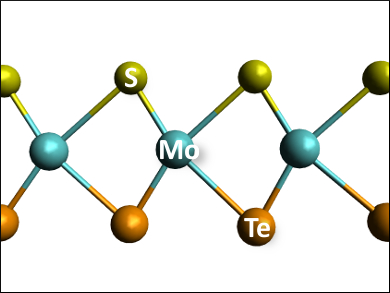Transition metal dichalcogenides (TMDCs) are some of the most widely studied 2D materials. There are over 100 different TMDCs to date, with new TMDC materials appearing quite frequently. TMDCs are often used in electronic devices, particularly at semiconducting junctions, where the electron-hole separation efficiency of the TMDC is critical for determining the performance of the device.
Zhi-Rui Gong, Shenzen University, China, and colleagues have proposed a new type of TMDC. The team performed calculations using time-domain density functional theory (TD-DFT) to predict the properties of the material. They used a projector augmented wave (PAW) method and a plane-wave basis set within the Vienna ab-initio simulation package (VASP). The material in question (pictured) has been coined Janus-MoSTe and could exhibit an out-of-plane electrical field. This is due to the difference in electronegativity between the sulfur and tellurium atoms. This out-of-plane field is thought to significantly lower the electron and hole interactions, giving rise to a low binding energy of 0.54 eV.
Further calculations showed that a slow recombination of the electrons and holes occurs, on a timescale around 1.31 ns—a value which is comparable to many van-der-Waals heterostructures. The results also show that the built-in electric field could potentially be used to control the electron-hole recombination dynamics within Janus-MoSTe monolayers.
- Prediction of an extremely long exciton lifetime in a Janus-MoSTe monolayer,
Hao Jin, Tao Wang, Zhi-Rui Gong, Chen Long, Ying Dai,
Nanoscale 2018.
https://doi.org/10.1039/c8nr04568b


